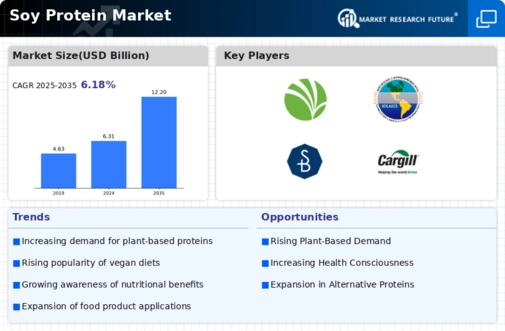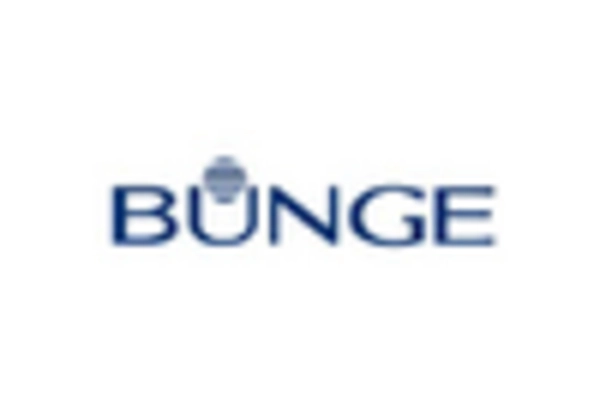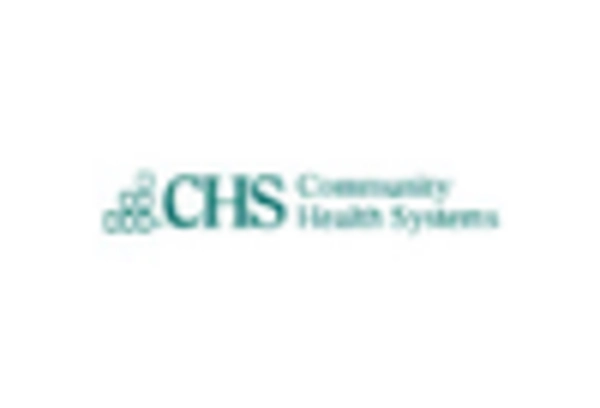Market Trends
Key Emerging Trends in the Soy Protein Market
The soy protein market is influenced by several key factors that impact its growth and dynamics. Firstly, changing dietary preferences and increasing health consciousness among consumers drive the demand for soy protein. As people become more aware of the health benefits associated with plant-based proteins, there's a growing preference for soy protein as a meat alternative and protein supplement. Soy protein is perceived as a nutritious, sustainable, and versatile ingredient, suitable for various food and beverage applications. Additionally, rising concerns about animal welfare, environmental sustainability, and the impact of meat consumption on health and the environment further fuel the demand for plant-based protein sources like soy.
Economic factors also play a significant role in shaping the soy protein market. Factors such as disposable income levels, purchasing power, and consumer spending patterns influence market demand. Higher disposable incomes often lead to increased spending on premium and specialty food products, driving market growth. Conversely, economic downturns or fluctuations can impact consumer purchasing behavior, leading to shifts towards more affordable protein sources or changes in consumption patterns. Moreover, currency fluctuations and trade policies also affect the pricing and availability of soy protein, impacting market dynamics and competitiveness.
Technological advancements in soy processing and protein extraction techniques contribute to market growth and expansion. Innovations in extraction, isolation, and purification methods enable the production of high-quality soy protein with improved nutritional profile, functionality, and sensory characteristics. Additionally, advancements in food formulation and ingredient blending techniques enhance the versatility and application potential of soy protein in various food products, including meat alternatives, dairy alternatives, and nutritional supplements. Moreover, developments in non-GMO soybean varieties and sustainable farming practices address consumer concerns about genetic modification and environmental impact, further driving market growth.
Regulatory factors also influence the soy protein market landscape. Government regulations related to food safety, labeling, and health claims impact product formulation, marketing strategies, and consumer trust. Compliance with these regulations is essential for market players to ensure product quality and safety, as well as to maintain consumer confidence. Moreover, policies related to agricultural subsidies, import tariffs, and sustainability practices impact the production, trade, and pricing of soy protein, shaping market trends and dynamics.
Market competition is intense in the soy protein sector, with numerous players vying for market share. The presence of both multinational corporations and smaller regional players fosters competition in terms of product quality, pricing, and innovation. Market players continually strive to differentiate their offerings through product innovation, branding, and marketing strategies to gain a competitive edge. Moreover, mergers, acquisitions, and strategic alliances among key players reshape the market landscape, driving consolidation and market concentration.
Consumer preferences and trends also influence the soy protein market. Emerging trends such as plant-based diets, clean label, and sustainability are driving demand for soy protein-based products that are natural, minimally processed, and environmentally friendly. Consumers are increasingly seeking products that are free from artificial additives, preservatives, and allergens, leading to the popularity of soy protein as a clean-label ingredient. Moreover, the rising demand for functional foods and beverages with added health benefits such as weight management, muscle recovery, and heart health further drive innovation and product development in the soy protein market.

















Leave a Comment